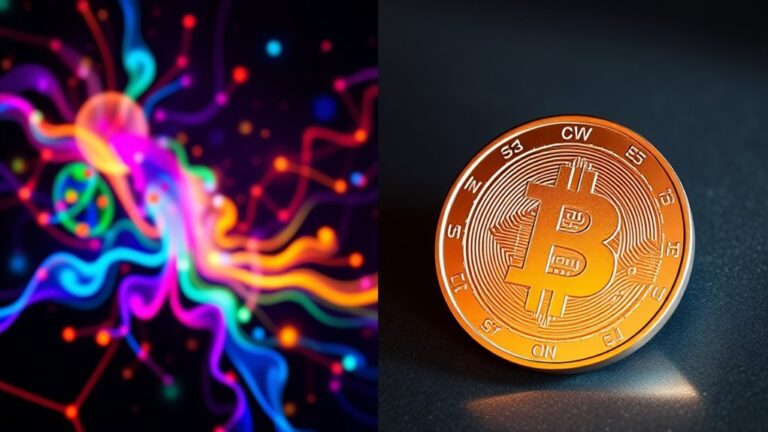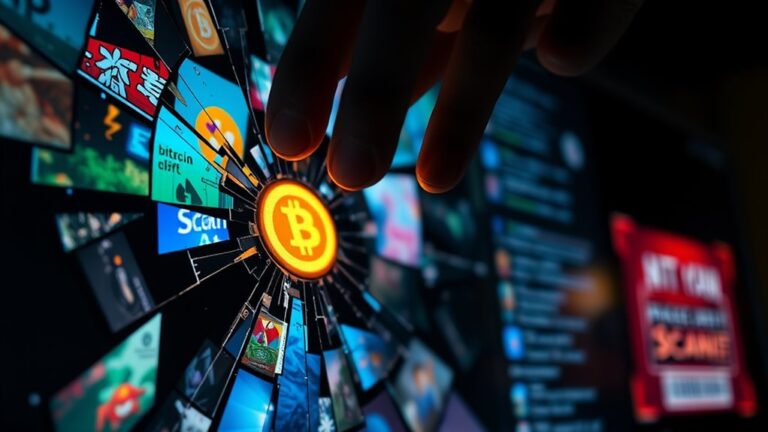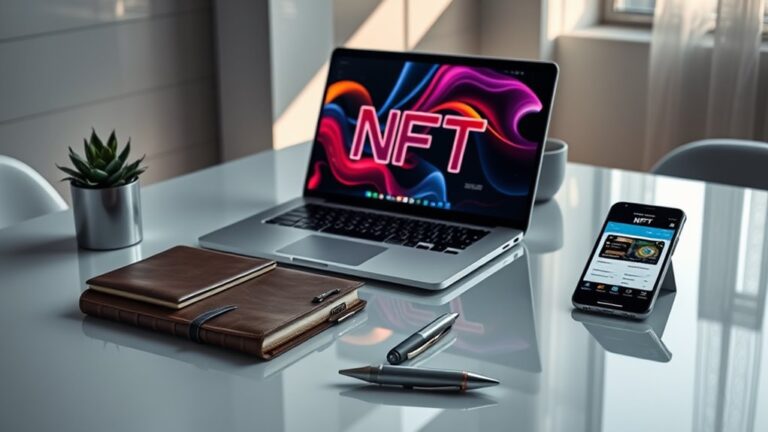
NFT Minting: How to Create Unique Blockchain Assets?
NFT minting is the process of creating unique digital assets on a blockchain. This establishes ownership and authenticity for items like art and music. To mint NFTs, one must select a suitable blockchain, such as Ethereum or Polygon. Setting up a digital wallet is essential for managing assets and transactions. After uploading the digital item and its metadata to an NFT marketplace, the transaction is confirmed, completing the minting process. Further details can enhance understanding of this evolving field.
Key Takeaways
- Choose a suitable blockchain for minting NFTs, with Ethereum, Solana, and Polygon being popular options based on cost and functionality.
- Set up a digital wallet compatible with your chosen blockchain to securely manage your NFTs and transactions.
- Create your digital asset, ensuring it is unique and has clear metadata that enhances its value and discoverability.
- Upload the asset to an NFT marketplace, fill in the required metadata, and confirm the transaction while paying any necessary fees.
- Promote your NFT through social media and community engagement to attract potential buyers and increase visibility in the market.
Understanding NFTs and Their Significance
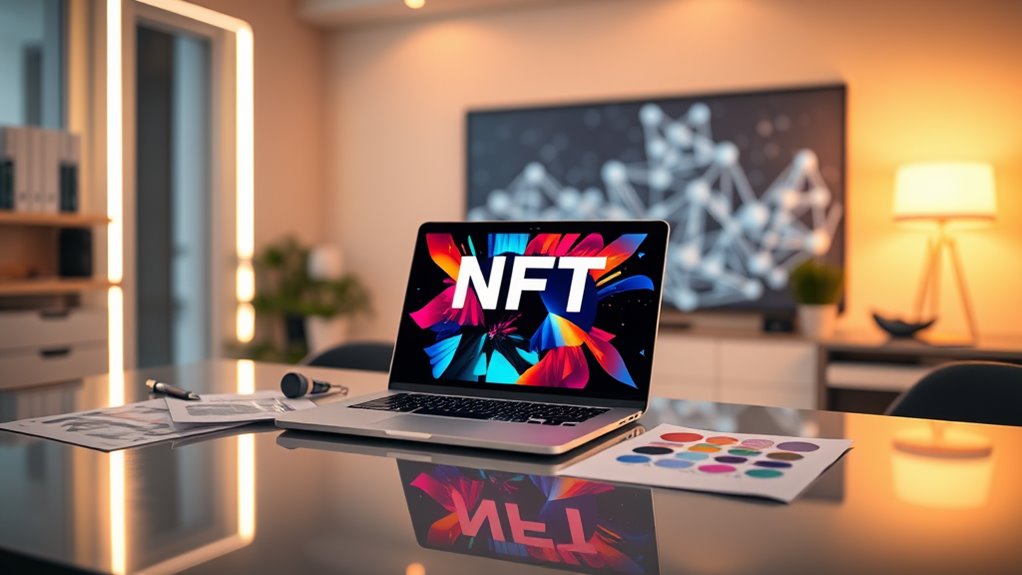
Non-fungible tokens, commonly known as NFTs, represent a significant advancement in the domain of digital assets. Unlike traditional cryptocurrencies, NFTs are unique digital assets that cannot be exchanged on a one-to-one basis. Each NFT has a distinct identifier on the blockchain, ensuring that it cannot be copied or substituted.
These tokens serve as certificates of authenticity and ownership for various items, including digital art, music, and even virtual real estate. While owning an NFT does not automatically confer intellectual property rights, it provides a public record of ownership. Additionally, the process of minting NFTs involves encrypting the asset’s information and recording it on a blockchain, which plays a crucial role in establishing their value and authenticity.
The market value of NFTs is influenced by supply and demand, reflecting their growing importance in the digital economy and transforming how individuals perceive ownership in the digital age.
Choosing the Right Blockchain for Minting

When selecting a blockchain for minting NFTs, several factors must be considered, including popularity, cost, and scalability.
Ethereum remains the leading choice due to its established marketplaces, but high gas fees can be a drawback. Alternatives like Solana, Polygon, and Flow offer lower costs and improved scalability, making them attractive options for creators looking to optimize their minting experience. Additionally, Ethereum’s ability to support smart contracts enhances its functionality for developers creating unique digital assets.
Popular Blockchain Options
Selecting the right blockchain for minting NFTs is a crucial decision that can greatly impact the overall experience for creators and collectors alike.
Ethereum remains the most popular choice, known for its extensive support but often associated with high gas fees.
Polygon offers a more cost-effective alternative while maintaining compatibility with Ethereum-based NFTs.
Solana is recognized for its low transaction fees and rapid processing times, making it appealing for creators.
Cardano, though less established, similarly offers lower fees.
Binance Smart Chain provides low costs but lacks the decentralization found in Ethereum.
Each blockchain presents unique features, so creators should consider transaction costs, marketplace support, security, and efficiency when making their selection. Furthermore, understanding the difference between NFTs and cryptocurrencies is essential for creators to navigate the digital asset landscape effectively.
Cost and Scalability Considerations
Cost and scalability factors play an essential role in the decision-making process for creators minting NFTs. The choice of blockchain can greatly impact both expenses and operational efficiency.
Key factors to take into account include:
- Variable Costs: Fluctuating minting costs due to network congestion.
- Gas Fees: Ethereum’s high fees contrast with lower rates on platforms like Polygon.
- Smart Contract Complexity: More complex contracts require higher computational power, increasing costs.
- Scalability: Blockchains like Solana and Polygon offer faster, cheaper transactions compared to Ethereum.
Understanding these aspects can help creators make informed decisions, balancing minting costs with potential sales and enhancing their overall market strategy while ensuring long-term sustainability for their NFT projects. Additionally, creators should be aware of the environmental impact associated with NFT minting, as certain blockchains consume vast amounts of energy, contributing to significant carbon emissions.
Setting Up Your Digital Wallet

Setting up a digital wallet is an essential step for anyone looking to engage with NFTs.
Various wallet types, such as MetaMask and Trust Wallet, cater to different blockchains and offer unique features.
It is vital to follow security best practices, including safeguarding recovery phrases and enabling two-factor authentication, to protect valuable digital assets. Additionally, understanding the key features of different wallets can help you choose the best option for your needs.
Wallet Types Overview
When choosing a digital wallet for NFT minting, it is essential to understand the different types available, as they each serve distinct purposes and have unique features.
The primary categories of digital wallets include:
- Software Wallets: User-friendly and easily accessible on devices, ideal for everyday use.
- Hardware Wallets: Physical devices that offer enhanced security for storing crypto assets.
- Paper Wallets: Physical documents containing wallet keys, providing a secure offline storage option.
- DeFi Wallets: Specialized wallets for interacting with decentralized finance applications.
Each wallet type offers varying levels of security, functionality, and compatibility with different blockchains. Additionally, crypto wallets are crucial for users to securely interact with the cryptocurrency ecosystem, ensuring a safe experience during NFT transactions.
Users should select a wallet that aligns with their needs, ensuring it supports the blockchain intended for NFT minting.
Security Best Practices
To guarantee the security of a digital wallet used for NFT minting, several best practices should be implemented during the setup process.
Utilizing a hardware wallet greatly enhances security by keeping private keys offline. Compartmentalizing assets across multiple wallets helps distribute risk. Activating two-factor authentication (2FA) adds an important layer against unauthorized access.
Regularly updating antivirus software protects devices from malware threats. It is essential to securely store the recovery phrase to prevent loss of wallet access. Users should also revoke unused permissions and verify smart contracts before signing.
Being aware of gas fees and avoiding phishing attempts are vital in maintaining wallet integrity. Following these practices can greatly reduce security risks associated with NFT transactions. Additionally, keeping software and apps up to date ensures users benefit from the latest security patches, further safeguarding digital assets.
Exploring NFT Marketplaces
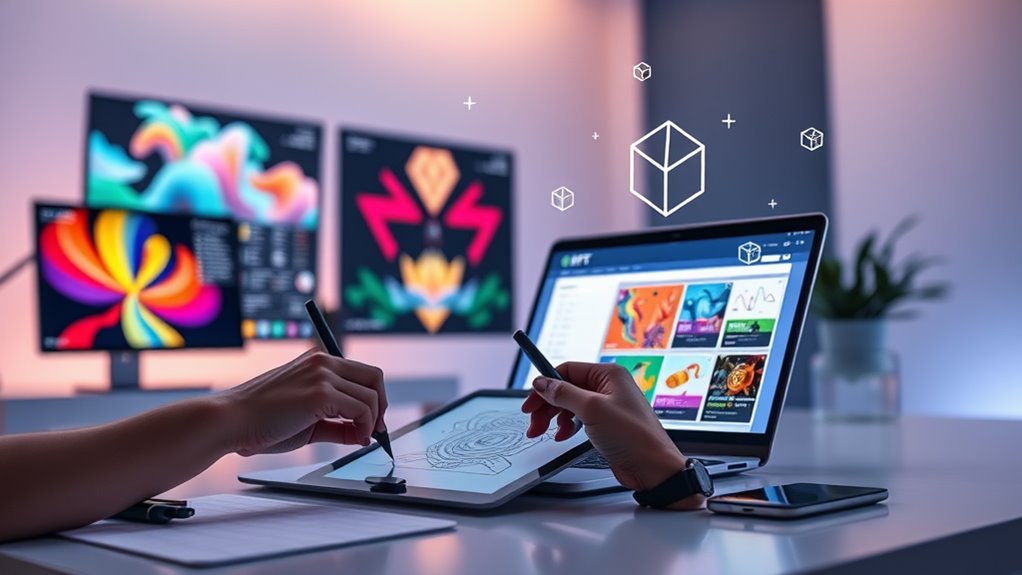
How does one navigate the diverse landscape of NFT marketplaces? Understanding the various types and their unique features is essential for both creators and collectors.
NFT marketplaces serve as platforms for buying, selling, and minting non-fungible tokens. Key aspects include:
NFT marketplaces are vital platforms for engaging in the buying, selling, and minting of non-fungible tokens.
- Open Marketplaces: Platforms like OpenSea allow anyone to participate.
- Curated Marketplaces: Sites such as SuperRare focus on vetted, high-quality NFTs.
- Niche Marketplaces: Specialized markets target specific interests like gaming or sports.
- Centralized vs Decentralized: Options vary regarding user control and ease of transactions.
These marketplaces offer opportunities for secure ownership and monetization of digital assets, but users must also be aware of market volatility and potential risks associated with transactions. Additionally, platforms like OpenSea stand out due to their extensive support for multiple blockchains, enhancing accessibility for users.
The Step-by-Step Minting Process

Minting NFTs involves a structured series of steps that creators must follow to transform their digital assets into unique blockchain tokens.
First, creators develop their digital asset, which can be artwork, music, or videos. Next, they select a blockchain, such as Ethereum or Solana, based on factors like transaction fees and processing speed. Setting up a crypto wallet is essential for handling transactions.
After preparation, creators upload their digital asset to a chosen NFT marketplace, adding necessary metadata such as name and description. The platform then generates a unique identifier for the NFT. Additionally, understanding market trends can help creators price their NFTs competitively.
Finally, creators confirm the transaction by paying the required fees, completing the minting process and establishing ownership of the newly created token.
Importance of Metadata in NFTs

The importance of metadata in NFTs cannot be overstated, as it plays a crucial role in defining and enhancing the value of these digital assets.
Metadata serves as descriptive information, detailing key characteristics and unique traits.
Key aspects of NFT metadata include:
- Authenticity: Establishes proof of ownership and creator history.
- Discoverability: Aids potential buyers in searching and filtering through attributes.
- Interoperability: Guarantees seamless integration across various platforms.
- Value Enhancement: Thorough metadata highlights rarity and uniqueness, increasing overall value.
Moreover, including detailed metadata can also facilitate NFT royalties to ensure creators receive compensation for their work in secondary sales.
Strategies for Promoting Your NFTs
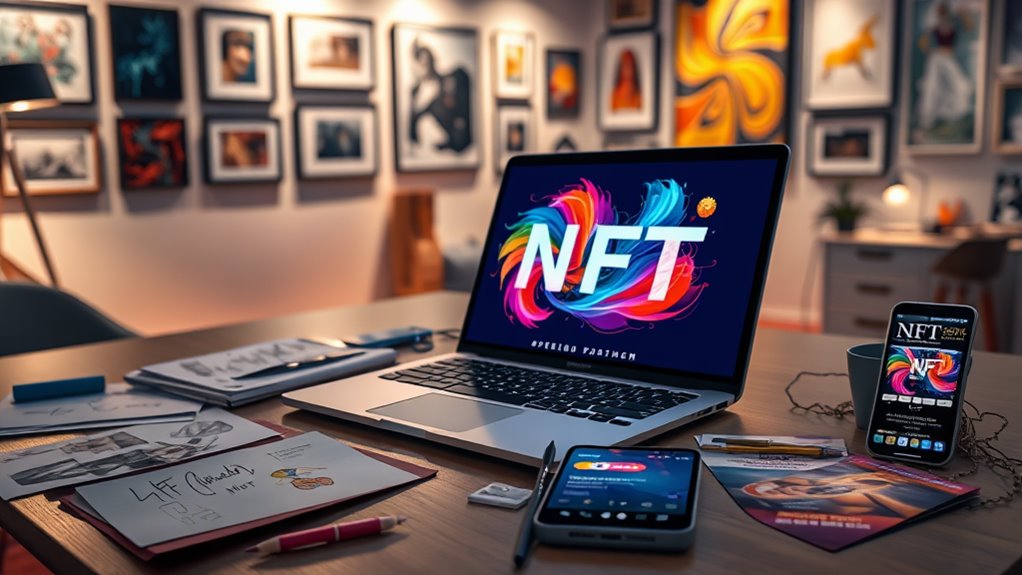
Promoting NFTs effectively requires a strategic approach that encompasses various marketing techniques tailored to reach potential buyers. Several tactics can enhance visibility and engagement within the NFT community.
| Strategy | Description |
|---|---|
| Social Media Presence | Utilize platforms like Twitter and Instagram to share engaging content and create buzz. |
| Influencer Partnerships | Collaborate with influencers to extend reach and gain credibility. |
| Community Engagement | Foster a strong community through events and contests to encourage interaction. |
Pricing and Selling Your NFTs
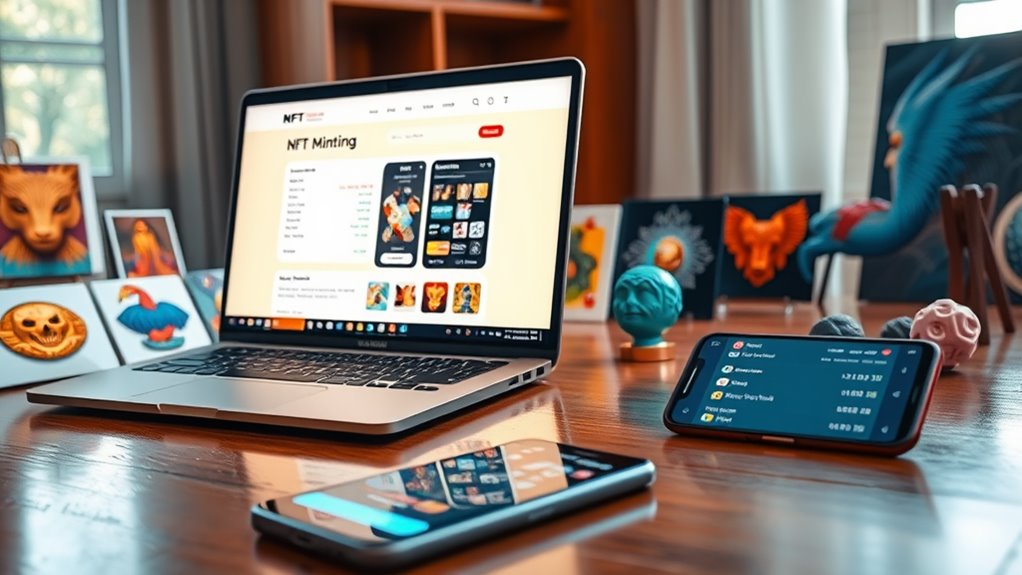
How can creators effectively price and sell their NFTs in a rapidly evolving marketplace? To optimize sales, several key considerations should be taken into account:
- Scarcity Factor: Limited editions generally command higher prices due to their rarity.
- Value Proposition: Offering benefits or unique features can justify premium pricing.
- Market Research: Analyzing current trends helps in setting competitive prices.
- Brand Reputation: Established brands can charge more based on their recognition.
Creators should also consider pricing strategies such as fixed pricing, auctions, and dynamic pricing.
Understanding the costs associated with different platforms, including gas fees, is essential for maximizing profitability.
Ultimately, a well-researched approach can enhance both pricing and selling effectiveness in the NFT market.
The Future of NFT Minting and Market Trends
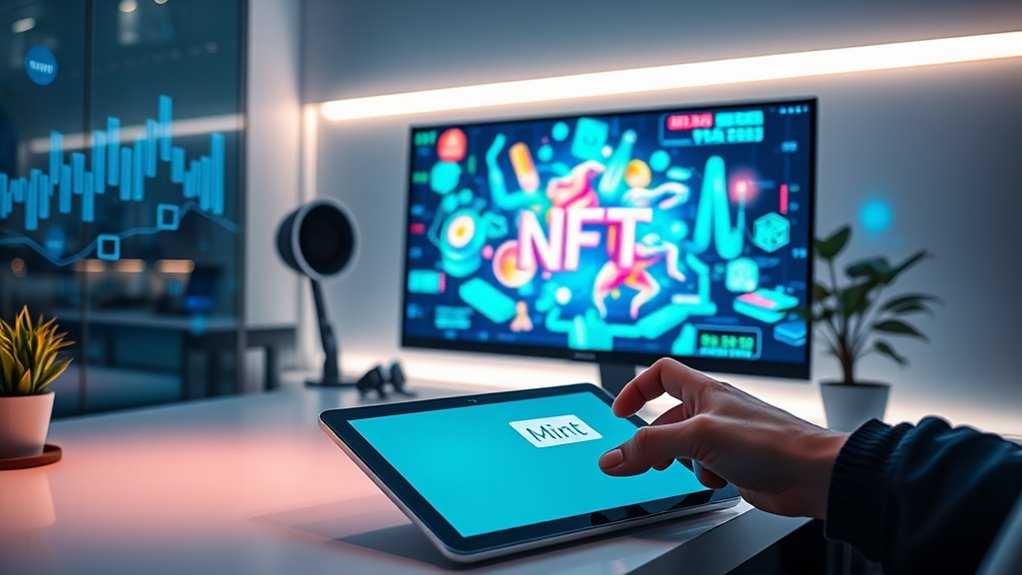
What trends are shaping the future of NFT minting and the market landscape? The NFT market is evolving rapidly, driven by several key trends.
Increased adoption of NFTs in various industries, such as real estate and gaming, is expanding their utility. Platforms like OpenSea and Rarible are enhancing user experiences through improved infrastructure and reduced transaction costs via Layer 2 solutions.
The rise of hybrid NFTs and Bitcoin NFTs is diversifying the market, allowing for new functionalities and broader access. In addition, innovative use cases, including AI integration and tokenized real-world assets, are emerging.
Predictions indicate significant market growth, projecting a valuation of $152.54 billion by 2030, underscoring the ongoing transformation of the NFT landscape.
Frequently Asked Questions
Can NFTS Be Created From Physical Items?
Yes, NFTs can be created from physical items. This process involves digitizing the items, linking them to blockchain records, and ensuring authenticity, thereby allowing ownership and provenance to be securely represented in a digital format.
What Is the Environmental Impact of NFT Minting?
Significantly, the remarkable environmental impact of NFT minting manifests through massive energy consumption, excessive carbon emissions, and e-waste generation. Consequently, increased awareness and adoption of sustainable practices are essential for mitigating these significant ecological concerns.
Are NFTS Transferable Between Different Blockchains?
NFTs are generally tied to specific blockchains, making transfers challenging. However, technologies like blockchain bridges enable cross-chain transfers by burning the original NFT and minting a new one, though metadata may not always transfer seamlessly.
How Do I Protect My NFTS From Theft?
In a world where digital treasures vanish quicker than a magician’s rabbit, one must secure NFTs with hardware wallets, stay vigilant against phishing, and employ two-factor authentication—because even pixels deserve protection from digital bandits.
What Happens if a Blockchain Hosting My NFT Goes Down?
If a blockchain hosting an NFT goes down, ownership remains intact on the blockchain. However, access to the NFT’s associated data may be affected, potentially disrupting trading and impacting market confidence temporarily.
Conclusion
In summary, NFT minting might seem like a modern alchemy, transforming digital art into gold, but it requires careful planning and execution. From selecting the right blockchain to understanding metadata, each step plays a vital role. While some may treat NFTs as mere collectibles, others see them as a new era of ownership in the digital domain. As trends evolve, aspiring creators must navigate this complex landscape, ensuring their unique assets don’t end up gathering virtual dust.



